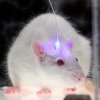Optogenetics, the ability to excite individual neurons in the brain with a beam of light, has been hailed as the single most important development in neuroscience in the last few years, maybe decade. We’ve been covering this technology with the hope that it can lead to new clinical applications, but the “genetics” part of optogenetics has been a reason for it to stay in the laboratory. That is because the technique requires the subject to be genetically modified to express a light sensitive protein normally produced by algae. Researchers at The University of Chicago have now modified the technique to work without having to perform genetic manipulation, a development that may help bring the technology into clinical practice.
The new method takes advantage of the recently discovered fact that normal, unmodified neurons can be activated using heat delivered by infrared light. On its own, this is dangerous to cells since infrared penetrates deep into tissue and way too many neural cells are affected at the same time to make any use of it. To overcome this, the researchers delivered gold nanoparticles to the cells that were targeted for manipulation and made them stick using a synthetic molecule. Shining a green colored laser at cells with gold nanoparticles on their surface activates their activity, with seemingly no cell damage. The researchers tested the technique by activating the same cells over 3,000 times in a span of a half hour, showing consistent response and no loss in the ability of the cells to energize in response to the stimulation.
“The technique is easy to implement and elicits neuronal activity using light pulses. Therefore, stimulating electrodes are not required,” said Francisco Bezanilla, PhD, professor of biochemistry and molecular biology. “Furthermore, with differently-shaped nanoparticles it can work in near-infrared as well as in visible wavelengths, which has many practical advantages in living animals. Thus far, most optogenetic tools have been limited to visible wavelengths.”
source:The University of Chicago
Breakthrough Allows Optogenetics without Genetic Manipulation

